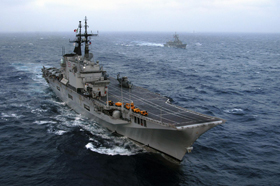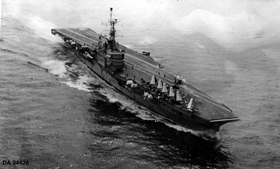The Indian Aircraft Carrier: The Search for Consensus Solutions
Aircraft Carrier INS Vikramaditya
In
Login if you are already registered
(no votes) |
(0 votes) |
RIAC Expert
A leader in the Asia-Pacific region, India boasts formidable military potential, most notably a strong naval presence. The country already possesses all the traits of a first-rate sea power, including nuclear submarines and carrier aviation. Though neither capability inspires great awe, current developments within India’s shipbuilding programs give evidence of future Indian claims and aspirations. Whereas complete maritime superiority in the Asia-Pacific region is unattainable as long as the United States continues to prosper, achieving parity with China, which has also been active in naval construction, appears to be quite feasible.
A leader in the Asia-Pacific region, India boasts formidable military potential, most notably a strong naval presence. The country already possesses all the traits of a first-rate sea power, including nuclear submarines and carrier aviation. Though neither capability inspires great awe, current developments within India’s shipbuilding programs give evidence of future Indian claims and aspirations. Whereas complete maritime superiority in the Asia-Pacific region is unattainable as long as the United States continues to prosper, achieving parity with China, which has also been active in naval construction, appears to be quite feasible.
Because the boundless expanses of the Indian and Pacific oceans open the region to military confrontation, India’s aircraft carrier program is fast becoming essential to its national security, in fact no less significant than its nuclear and air force capabilities. India has a 50-year-long record of operating aircraft-capable ships, while the current navy construction program envisions commissioning three new aircraft carriers within the next 15 years, two of them to be built in India. These three carriers will give the Indian navy two constantly ready carrier battle groups.
The Long Journey to a National Aircraft Carrier
The history of the Indian aircraft carrier program is inseparable from two ships, the INS Vikrant and INS Viraat. The INS Vikrant became the first Indian carrier, built back in 1945 by two shipyards – Vickers-Armstrong and Harland and Wolff. Named the HMS Hercules, it was intended to be deployed in the Royal Navy, but never reached its destination, as it was laid up during the post-war program to reduce the size of the navy. In 1957, the ship was sold to India and in 1961 commissioned into the Indian Navy as the INS Vikrant. This relatively small 20,000-ton carrier could hold on board 20 to 25 aircraft, including the deck-based fighters Hawker Sea Hawk, anti-submarine airplanes Breguet Br.1050 Alizé, and the American Sea King and French Alouette helicopters.
The carrier went often out at sea for exercises and combat missions, and took part in the 1971 Indo-Pakistani war, when its fighter aircraft attacked Chittagong, Cox's Bazar, Khulna and Mongla in East Pakistan (now Bangladesh). During the early 1980s, the Vikrant's badly outdated Sea Hawks were replaced by VTOL Sea Harrier jet fighters. In 1997, 52 years after its construction and with 36 years of service under the Indian flag, the INS Vikrant was decommissioned and preserved as a museum in Mumbai.

In 1987, the Indian Navy obtained its second
aircraft carrier, the INS Viraat
In 1987, the Indian Navy obtained its second aircraft carrier, the INS Viraat. Formerly the HMS Hermes, this Centaur-class light carrier was built by Vickers-Armstrong in 1944, commissioned in 1953, and handed over to the Royal Navy in 1959. After World War II, the British economy was too strained to pay for the rapid construction of large battleships. The carrier served under the flag of St. George for 27 years and completed successful operations during the 1982 Folklands War as the carrier group flagship. In April 1986, the ship was sold to India and renamed the INS Viraat; a year later, after repairs and refitting, the carrier shipped off to the Indian Ocean. With its 28,700-ton displacement, it is larger than the INS Vikrant and can carry on board 30-35 aircraft, although its airgroup has never exceeded 20-25 units (as many as its predecessor usually took on board). The ship has been equipped with Sea Harrier jet fighters and Sea King helicopters of the anti-submarine and amphibious assault versions, as well as Russian helicopters - the Ka-28 anti-submarine and Ka-31 early warning helicopters.
Conceptual Evolution from STOVL to STOBAR
India has a 50-year-long record of operating aircraft-capable ships, while the current navy construction program envisions commissioning three new aircraft carriers within the next 15 years, two of them to be built in India.
Realizing that both ships were becoming obsolete and in disrepair, in 1989, Indian Navy commanders decided to build two more 28,000-ton carriers. The first one was intended as a substitute for the INS Vikrant, while the second was to replace Viraat in the mid-2000s. The construction of the first ship was planned for the Cochin Shipyard in 1993, but by 1991, the Committee on Defense Expenditure informed the Indian Navy that it would abandon plans for large aircraft carriers and shift the focus to the Italian Garibaldi Class, known as one of the world's smallest aircraft carriers with 10,000 tons standard and 13,850 tons total displacement.
Indian admirals circled the wagons, because the idea of deploying ships twice as small as the 28,000-ton Vikrant and 29,000-ton Viraat was unacceptable. But in the end, the process of designing the new carrier for 12-15 aircraft started anyway, although the Navy could not increase the permitted displacement over 17,000 tons. In 1997, the situation reversed, as the Indian Navy began to seriously consider the ADS (Air Defense Ship) project – a 24,000-ton ship with a 20-25-strong airwing based on designs completed by the French DCNS company.

Italian Garibaldi Class, known as one of
the world's smallest aircraft carriers with 10,000
tons standard and 13,850 tons total displacement.
Since this development, the dimensions of future shipbuilding projects continue to rise, among other reasons because STOVL aircraft carriers are visibly inferior to those that employ full-blown jet fighters. Made according to the CATOBAR pattern (catapult takeoff and arrester landing) or STOBAR (ski-jump launch as with STOVL and arrester landing as with CATOBAR), these carriers simply do not conform to the initial limits on dimensions.
In 2001, the Cabinet Committee on Security set the future carrier's displacement at a level of 30,000 tons. In February 2002, Admiral Madhvendra Singh, Chief of Naval Staff of the Indian Navy, presented a 32,000-ton design that envisaged a 25-meter-long flight deck and a 30-aircraft airwing. One month later, in March 2002, Indian Defense Minister Shri George Fernandes stated that the navy was in need of a 37,500-ton and 28-knot ship, with the total displacement of over 40,000 tons [1].
A Russian Touch for an Indian Carrier
In the first half of the 2000s, Indian defense forces began purchasing Russian SU-30 jet fighters - first the SU-30KN intermediate version and then the full-fledged SU-30MKI with state-of-the-art electronics and powerful weapons. Equally effective for dogfight and precision attacks on surface targets, these multipurpose aircraft have radically changed the Indian vision of modern aviation.
Around the same time, the Indian Navy, which had already successfully operated Soviet ships, submarines and helicopters, agreed to a Russian proposal of refitting the aircraft carrier Admiral Gorshkov according to Indian specifications as well as purchasing MIG-29K jets. Similar to the Sukhoi platform that was then undergoing a major evolution, these fighter jets could efficiently perform both air defense and strike functions. The arrival of these new capabilities has changed the future carrier's designation from ADS (Air Defense Ship) to IAC (Indigenous Aircraft Carrier), plus other known designations of Indian Aircraft Carrier and Project-71.
In global military language, aircraft carrier means a multipurpose carrier, whereas indigenous in this case signifies a project's national level, a top priority and mostly independent ascription.
Indian admirals circled the wagons, because the idea of deploying ships twice as small as the 28,000-ton Vikrant and 29,000-ton Viraat was unacceptable. But in the end, the process of designing the new carrier for 12-15 aircraft started anyway, although the Navy could not increase the permitted displacement over 17,000 tons.
At the same time, foreign specialists participated in designing the ships because Indians were not yet ready to take full responsibility for that part of the process. Delhi officially would not acknowledge the ship's foreign ties, but media outlets reported the role of the Italian shipbuilder Fincantieri.
Russian specialists must have also been involved, such as representatives from the aircraft corporation MIG (the future supplier of jets for the Indian Navy), and the Nevsky Design Bureau (a designer of Soviet aircraft carriers with experience in harmonizing carrier systems to handle the MIG-29K fighter).
The Ill-Fated Soviet Carrier
The Indian-built Vikrant, which inherited its name from the old Vikrant decommissioned in 1997, was constructed at the Cochin Shipyard in 2009. Currently it is expected to enter service in 2017, but the deadline may be postponed because the task of building such a large vessel is still quite new for Indian shipbuilders. Because of this, the carrier Admiral Gorshkov, renamed the INS Vikramaditya, will be the flagship of the Indian aircraft carrier program.
In summer 2012, the Indians began work on the second carrier within the IAC program, with the INS Vishal to join Vikramaditya and new Vikrant in early 2020s. Vishal should be visibly larger than both of them, with a total displacement of 65,000 tons against their levels of 40,000. The ship would automatically make India a global leader in carrier-building, as even the United Kingdom cannot afford to build the CATOBAR.
Rumors of the ship’s possible sale to India surfaced back in late 1990s, alongside plans to rebuild it into a classic carrier with 20-25 MIG-29 aircraft on board. Signed in 2004, the sales contract obliged Russia to handover both the ship and the deck-based aircraft to India, as well as train the crew, all for a price of 1.5 billion USD. Repairs and upgrades were completed at the Severodvinsk Machine-Building Enterprise.
The Admiral Gorshkov was renamed after Vikramaditya, a historical hero from India. The refurbished Gorshkov is architecturally reminiscent of the smaller Admiral Kuznetsov carrier, as anti-ship missiles were removed and the ship was equipped with a bow-to-stern deck with a ski-jump in the front, new air-defense systems and radio-electronic weapons. The Indian Navy plans to use it in conjunction with the Russian-built Project 11356 frigates and their Indian follow-ups known as Project 17.
Initially, the ship’s handover was set for 2008, but soon it became clear that the scope of work was much greater in scale and more time was needed. Moreover, the Severodvinsk Enterprise specializes in the construction of nuclear submarines and had never handled such a huge ship before. As a result, the cost of the contract price increased to 2.2 billion USD. The commissioning date was moved back to 2010 and then again to 2012. Presently, the total sum of the contract, which includes the aircraft and the training facility in Goa, may be as high as five billion USD.
In 2012, the ship was about to depart for India, but the boiler-and-turbine power plant did not pass a range of final tests. The Indian Navy had rejected the asbestos lining of upgraded boilers on ecological grounds, but the replacement asbestos-free coat failed when the carrier sailed at full speed. As a result, the handover was postponed to the fall of 2013. Before that date, the ship’s power generation capabilities must be in accordance with Russian standards and undergo another set of tests. At the same time, during a round of trials taking place in the summer and fall of 2012, the Vikramaditya operated successfully over long distances, displaying fine seaworthiness, maneuverability and simple functionality, as well as proper implementation of carrier requirements with numerous launches and landings of the MIG-29K jets completed.
The MIG-29K will not be the only aircraft to be based on Indian carriers, which are also going to receive the deck version of the Indian-made HAL Tejas fighter. In light of future supply contracts of the 126 French Rafale jets to the Indian Air Force, the purchase of its sea-based version is also very likely, at least if placed onboard a Indian carrier to be built in the future that should surpass both Vikrant and Vikramaditya in size [2].
The Super-Carrier and Dreams of Dominium Maris
In summer 2012, the Indians began work on the second carrier within the IAC program, with the INS Vishal to join Vikramaditya and new Vikrant in early 2020s. The Vishal should be visibly larger than both of them, with a total displacement of 65,000 tons against their levels of 40,000. Describing the future ship in 2010, Admiral Nirmal Kumar Verma, Chief of the Naval Staff of Indian Navy, said it would be "much bigger and capable of operating fighters, AEW (airborne early-warning) aircraft, tankers etc.".
These requirements automatically rule out the STOBAR system used for the Vikramaditya and new Vikrant, because early-warning and tanker aircraft need the full-fledged CATOBAR, which is functionally close to U.S. super-carriers and French Charles de Gaulle. However, the ship may employ a combined pattern – the ski-jump in the bow and catapults in the angle deck, as had been planned for the still under construction Soviet carrier Ulyanovsk.
The ship would automatically make India a global leader in carrier-building, as even the United Kingdom cannot afford to build the CATOBAR. With regards to the potential of the Indian Navy potential to carry out this program, we might draw the following conclusions:
- The Indian Navy is overwhelmingly superior to the Pakistani Navy, with its advantage having become absolute because of the systemic degradation in the Pakistani forces.
- Even the existing Indian carrier program appears more elaborate than the Chinese counterpart, at least for now based on the combination of the carrier Liaoning (former Varyag) and J-15 fighters (a SU-33 knockoff). The two 40,000-ton ships holding onboard over 40 MIG-29K jets (16 on each in its standard version) and about 20 helicopters considerably surpass the 60,000-ton Liaoning with its 18-20 J-15 aircraft (a maximum of 12 in the standard version). Placing more jets onboard will be difficult because SU-3 and J-15 are both heavy and bulky. Because of this, the potentially higher strike capacity of the Chinese fighter will be overpowered by the more numerous Indian jets and the capabilities of the Russian-built high-quality escort ships owned by the Indian Navy.
- Upon commissioning the third carrier (over 60,000 tons, up to 40 MIG-29K, Rafale and Tejas aircraft), India will be at par or even superior to China, even if the latter obtains three J-15 carriers. Beijing will only be able to tip the balance if it acquires an aircraft more suitable for deck-basing than the SU-33/J-15, which seems hardly viable, or if it builds 100,000-ton American-style super-carriers fit for heavy fighters. Notwithstanding the complexity of construction, the second option will also evoke a tough U.S. response, with a Washington-Delhi military union seeming practically inevitable. As a result, China should either content oneself with parity with India, or prepare for a full-scale confrontation with the global military leader.
1. Main stages presented as per: Air Defence Ship Evolution
2. Key stages presented as per: "Baku, Admiral Gorshkov, Vikramaditya: the Carrier History"
(no votes) |
(0 votes) |






